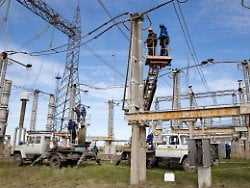Three days of test operation
Ukraine wants to decouple power grid from Russia
2/17/2022 4:37 am
Does Ukraine need electricity from Russia and Belarus? In the next few days, the country wants to separate itself from the electricity grids of its neighbors as a test and check whether the “island operation” works. The country also wants to break away from the Soviet past when it comes to the power grid.
In the coming week, Ukraine intends to test operation of its own power grid isolated from Russia, Belarus and the EU for the first time. The test is scheduled for February 24-26, state power grid operator Ukrenerho said. Ukraine wants to supply itself with electricity together with the neighboring Republic of Moldova without the neighbors. The process is not to be understood as a stress test, the company emphasized.
After another decoupling test in the summer, the ex-Soviet republic intends to permanently join the Association of European Transmission System Operators (ENTSO-E) from next year. This should also mark a break with the Soviet past in the power grid. Since 2003, part of the power grid in western Ukraine has been synchronized with its western neighbors. Most recently, however, Kiev had to resort to electricity imports from Belarus due to a lack of coal and natural gas.
The parts of the eastern Ukrainian regions of Donetsk and Luhansk on the Russian border that have been under the control of separatists since 2014 were separated from Kiev in 2017. A peace plan agreed in 2015 with Franco-German mediation actually envisages economic reintegration of the region.
EU approves billions in credit
The EU Parliament has cleared the way for 1.2 billion euros in financial aid for Ukraine. On Wednesday evening in Strasbourg, MEPs approved a proposal by the EU Commission to make these funds available to Ukraine as a loan. The EU Commission proposed the loan, which has a term of twelve months and is to be paid out in two tranches, to the EU Parliament and the member states at the end of January. The 27 member states approved the proposal on Friday.
The aim of the EU is to “provide rapid support in an acute crisis situation and to strengthen Ukraine’s resilience,” according to the decision of the EU Parliament. The first tranche is to be disbursed in the short term if Ukraine meets certain conditions. Among other things, it must demonstrate progress in implementing a reform program drawn up by the International Monetary Fund (IMF).
